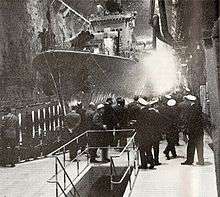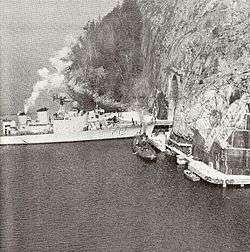Muskö naval base
| Muskö Naval Base | |
|---|---|
| Sweden | |
|
HSwMS Sundsvall entering one of the openings to the naval base. | |
| Type | Underground naval base. |
| Site information | |
| Controlled by | Sweden |
| Site history | |
| Built | 1950-1969 |
| In use | 1955–present |
| Materials | Concrete, stone, steel |
| Battles/wars | None |

Muskö Naval Base is a Swedish underground naval facility on the island of Muskö just south of Stockholm in Haninge Municipality (Haninge Kommun).
The construction of the base started in 1950 and was completed 19 years later in 1969. During the construction about 1.5 million tons of rock were removed. It has 3 docks, originally designed for destroyers and submarines. The underground base itself has an area of several km² and is connected by 20 km (12 mi) of underground roads. A 3 km (1.9 mi) long, dangerously narrow road tunnel running some 70 metres (230 ft) under the sea level connects the mainland and Muskö island.[1]
During the Cold war the underground facility was kept highly secret and not much information about it was known to the public.[2] In 2004 the Swedish government decided that the navy should be concentrated to two bases only, the Karlskrona Naval Base and the Berga Naval Base, and much of the Muskö base was closed. Today some parts of the facility are still used by the military. The underground shipyards are operated by Kockums AB[3] and Muskövarvet AB.
One of the Swedish submarine incidents in October, 1982, took place at Muskö naval base.[4][5]
A survey carried out in 2000 concluded that sedimentation in the tunnels leading to docks contained PCBs, organotin compounds and heavy metals, mainly mercury and copper.[6]
References
| Wikimedia Commons has media related to Musköbasen. |
- ↑ Salo, Ilkka; Svenson, Ola (September 2003), Safety Management: A Frame of Reference for Studies of Nuclear Power Safety Management and Case Studies from Non-Nuclear Contexts (PDF), Nordic nuclear safety research (NKS), NKS-88, Roskilde, Denmark: NKS Secretariat, pp. 9–13, ISBN 87-7893-146-0, retrieved 2010-11-27
- ↑ Skoglund, Helene; Nynäshamns Posten (January 2010). "Musköbasen 40 år" [Muskö Naval Base 40 years] (PDF) (in Swedish). Stockholm: Kungliga Motorbåt Klubben. pp. 4–7. Retrieved 2010-11-09.
- ↑ Kockums AB. "Kockums shipyard facilities at Muskö". Retrieved 2010-11-09.
- ↑ Ola Tunander (24 September 2004). The secret war against Sweden: US and British submarine deception in the 1980s. Psychology Press. p. x. ISBN 978-0-7146-5322-8. Retrieved 8 November 2010.
- ↑ Keith Hartley; Todd Sandler (1990). The Economics of defence spending: an international survey. Routledge. p. 154. ISBN 978-0-415-00161-8. Retrieved 9 November 2010.
- ↑ Ulf Qvarfort; Annie Waleij; Henrik Mikko (March 2002). "Sedimentundersökning i förtunnlarna vid Musköbasen" [Survey of Muskö Naval Base foretunnel sediments] (PDF) (in Swedish). Umeå, Sweden: Totalförsvarets Forskningsinstitut: 3. ISSN 1650-1942. FOI-R--0497--SE. Retrieved 2010-11-10.
Coordinates: 58°58′47″N 18°03′50″E / 58.97967°N 18.063827°E
